Case Study Analysis of Nursing Professional
VerifiedAdded on 2022/09/01
|9
|2424
|19
AI Summary
Contribute Materials
Your contribution can guide someone’s learning journey. Share your
documents today.
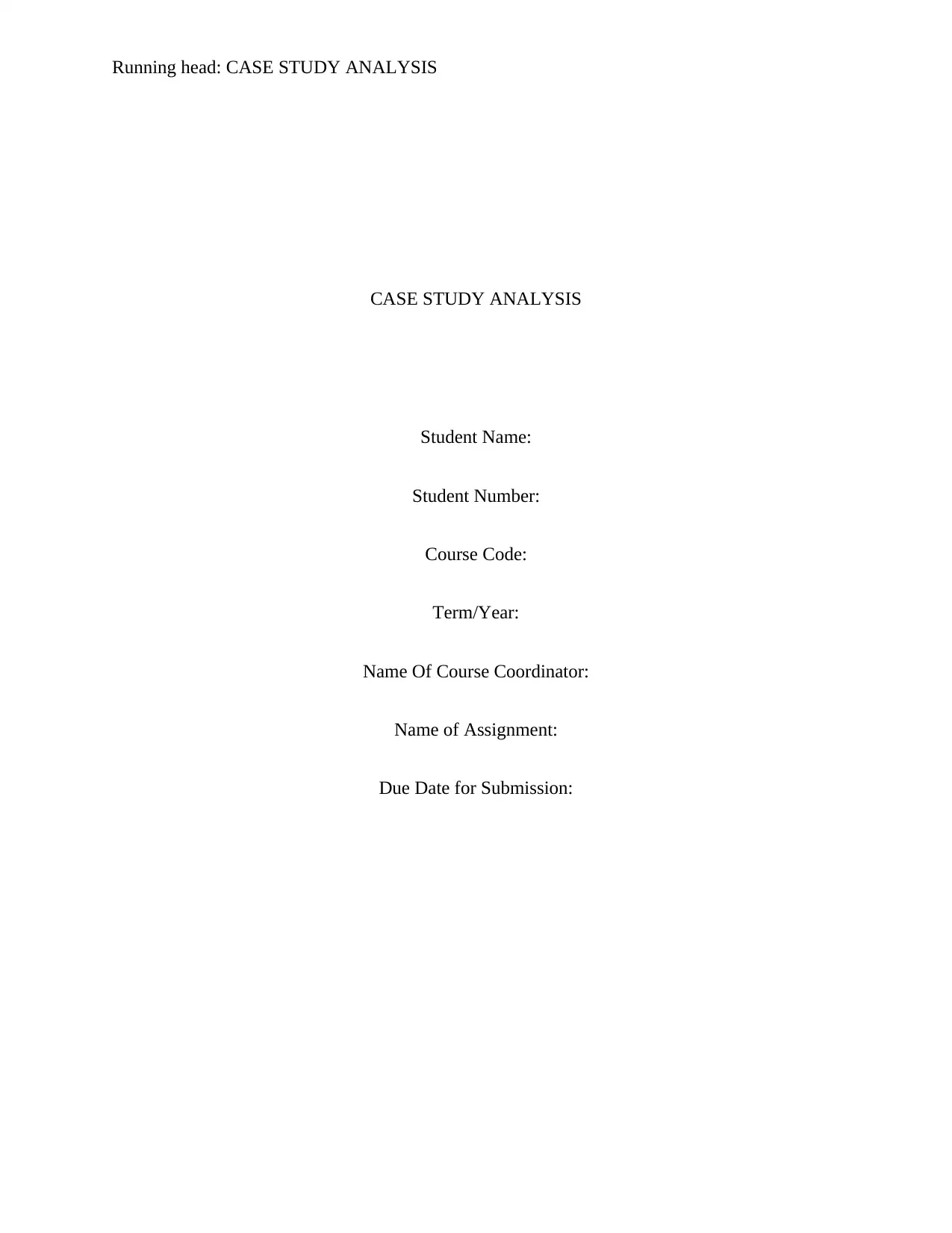
Running head: CASE STUDY ANALYSIS
CASE STUDY ANALYSIS
Student Name:
Student Number:
Course Code:
Term/Year:
Name Of Course Coordinator:
Name of Assignment:
Due Date for Submission:
CASE STUDY ANALYSIS
Student Name:
Student Number:
Course Code:
Term/Year:
Name Of Course Coordinator:
Name of Assignment:
Due Date for Submission:
Secure Best Marks with AI Grader
Need help grading? Try our AI Grader for instant feedback on your assignments.
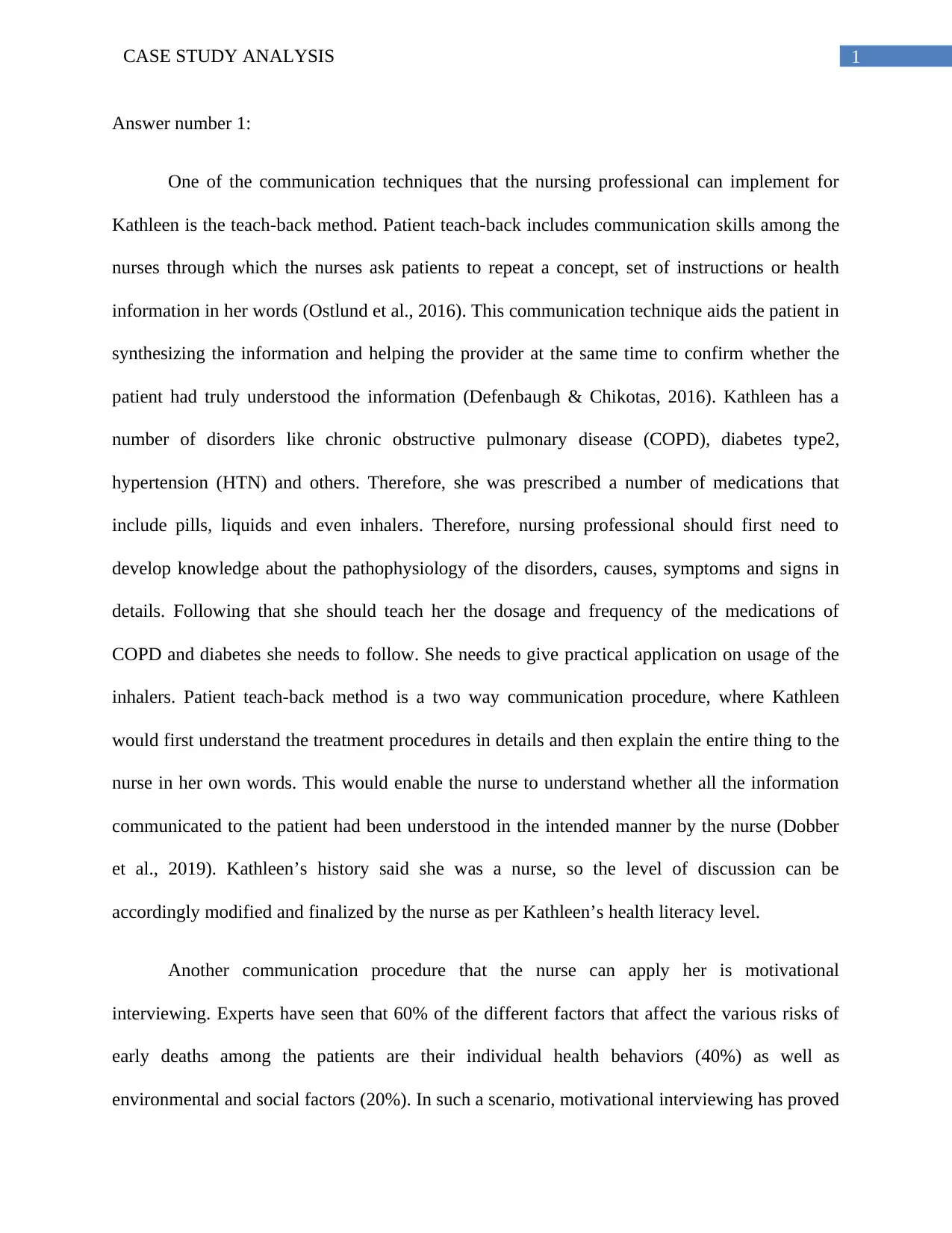
1CASE STUDY ANALYSIS
Answer number 1:
One of the communication techniques that the nursing professional can implement for
Kathleen is the teach-back method. Patient teach-back includes communication skills among the
nurses through which the nurses ask patients to repeat a concept, set of instructions or health
information in her words (Ostlund et al., 2016). This communication technique aids the patient in
synthesizing the information and helping the provider at the same time to confirm whether the
patient had truly understood the information (Defenbaugh & Chikotas, 2016). Kathleen has a
number of disorders like chronic obstructive pulmonary disease (COPD), diabetes type2,
hypertension (HTN) and others. Therefore, she was prescribed a number of medications that
include pills, liquids and even inhalers. Therefore, nursing professional should first need to
develop knowledge about the pathophysiology of the disorders, causes, symptoms and signs in
details. Following that she should teach her the dosage and frequency of the medications of
COPD and diabetes she needs to follow. She needs to give practical application on usage of the
inhalers. Patient teach-back method is a two way communication procedure, where Kathleen
would first understand the treatment procedures in details and then explain the entire thing to the
nurse in her own words. This would enable the nurse to understand whether all the information
communicated to the patient had been understood in the intended manner by the nurse (Dobber
et al., 2019). Kathleen’s history said she was a nurse, so the level of discussion can be
accordingly modified and finalized by the nurse as per Kathleen’s health literacy level.
Another communication procedure that the nurse can apply her is motivational
interviewing. Experts have seen that 60% of the different factors that affect the various risks of
early deaths among the patients are their individual health behaviors (40%) as well as
environmental and social factors (20%). In such a scenario, motivational interviewing has proved
Answer number 1:
One of the communication techniques that the nursing professional can implement for
Kathleen is the teach-back method. Patient teach-back includes communication skills among the
nurses through which the nurses ask patients to repeat a concept, set of instructions or health
information in her words (Ostlund et al., 2016). This communication technique aids the patient in
synthesizing the information and helping the provider at the same time to confirm whether the
patient had truly understood the information (Defenbaugh & Chikotas, 2016). Kathleen has a
number of disorders like chronic obstructive pulmonary disease (COPD), diabetes type2,
hypertension (HTN) and others. Therefore, she was prescribed a number of medications that
include pills, liquids and even inhalers. Therefore, nursing professional should first need to
develop knowledge about the pathophysiology of the disorders, causes, symptoms and signs in
details. Following that she should teach her the dosage and frequency of the medications of
COPD and diabetes she needs to follow. She needs to give practical application on usage of the
inhalers. Patient teach-back method is a two way communication procedure, where Kathleen
would first understand the treatment procedures in details and then explain the entire thing to the
nurse in her own words. This would enable the nurse to understand whether all the information
communicated to the patient had been understood in the intended manner by the nurse (Dobber
et al., 2019). Kathleen’s history said she was a nurse, so the level of discussion can be
accordingly modified and finalized by the nurse as per Kathleen’s health literacy level.
Another communication procedure that the nurse can apply her is motivational
interviewing. Experts have seen that 60% of the different factors that affect the various risks of
early deaths among the patients are their individual health behaviors (40%) as well as
environmental and social factors (20%). In such a scenario, motivational interviewing has proved
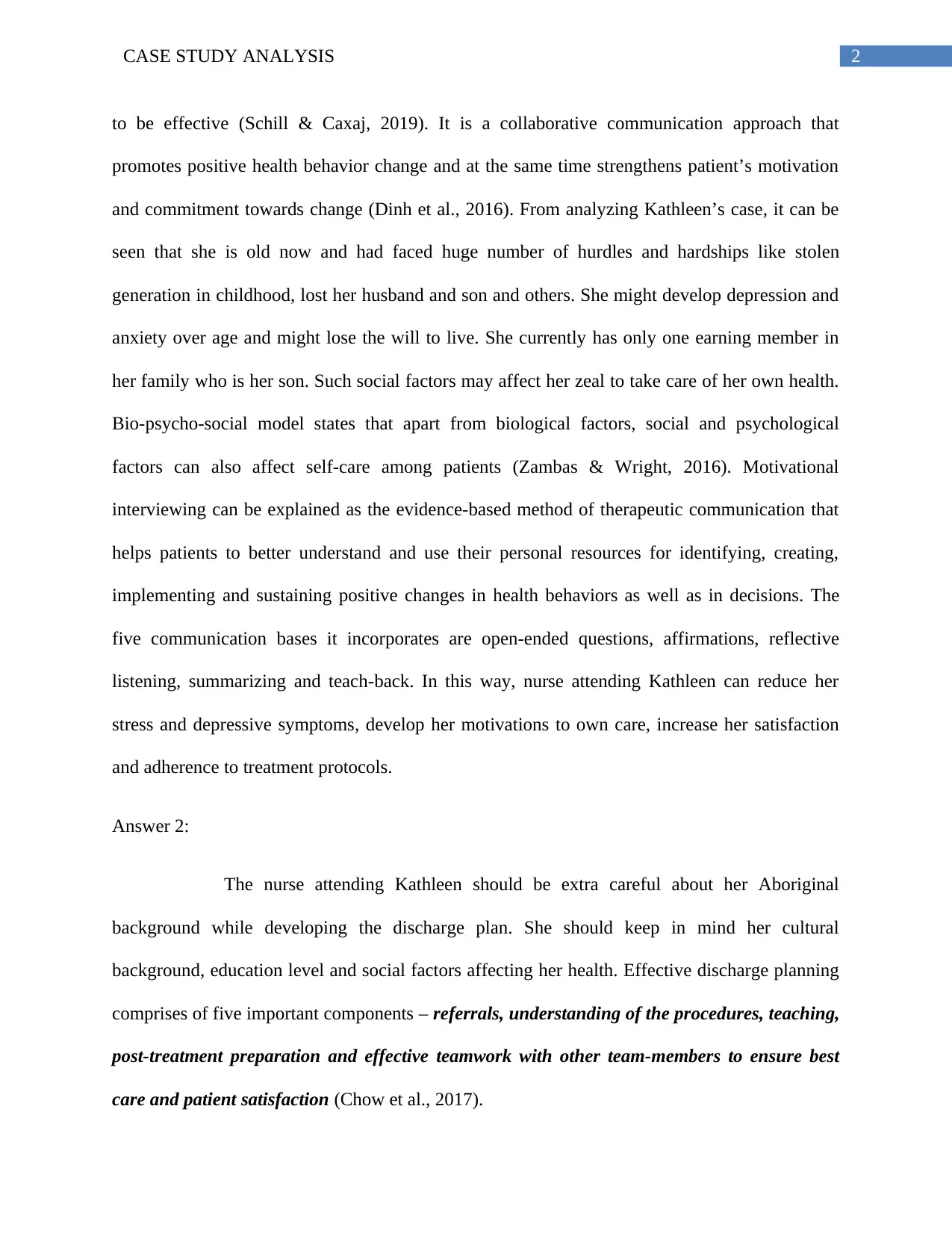
2CASE STUDY ANALYSIS
to be effective (Schill & Caxaj, 2019). It is a collaborative communication approach that
promotes positive health behavior change and at the same time strengthens patient’s motivation
and commitment towards change (Dinh et al., 2016). From analyzing Kathleen’s case, it can be
seen that she is old now and had faced huge number of hurdles and hardships like stolen
generation in childhood, lost her husband and son and others. She might develop depression and
anxiety over age and might lose the will to live. She currently has only one earning member in
her family who is her son. Such social factors may affect her zeal to take care of her own health.
Bio-psycho-social model states that apart from biological factors, social and psychological
factors can also affect self-care among patients (Zambas & Wright, 2016). Motivational
interviewing can be explained as the evidence-based method of therapeutic communication that
helps patients to better understand and use their personal resources for identifying, creating,
implementing and sustaining positive changes in health behaviors as well as in decisions. The
five communication bases it incorporates are open-ended questions, affirmations, reflective
listening, summarizing and teach-back. In this way, nurse attending Kathleen can reduce her
stress and depressive symptoms, develop her motivations to own care, increase her satisfaction
and adherence to treatment protocols.
Answer 2:
The nurse attending Kathleen should be extra careful about her Aboriginal
background while developing the discharge plan. She should keep in mind her cultural
background, education level and social factors affecting her health. Effective discharge planning
comprises of five important components – referrals, understanding of the procedures, teaching,
post-treatment preparation and effective teamwork with other team-members to ensure best
care and patient satisfaction (Chow et al., 2017).
to be effective (Schill & Caxaj, 2019). It is a collaborative communication approach that
promotes positive health behavior change and at the same time strengthens patient’s motivation
and commitment towards change (Dinh et al., 2016). From analyzing Kathleen’s case, it can be
seen that she is old now and had faced huge number of hurdles and hardships like stolen
generation in childhood, lost her husband and son and others. She might develop depression and
anxiety over age and might lose the will to live. She currently has only one earning member in
her family who is her son. Such social factors may affect her zeal to take care of her own health.
Bio-psycho-social model states that apart from biological factors, social and psychological
factors can also affect self-care among patients (Zambas & Wright, 2016). Motivational
interviewing can be explained as the evidence-based method of therapeutic communication that
helps patients to better understand and use their personal resources for identifying, creating,
implementing and sustaining positive changes in health behaviors as well as in decisions. The
five communication bases it incorporates are open-ended questions, affirmations, reflective
listening, summarizing and teach-back. In this way, nurse attending Kathleen can reduce her
stress and depressive symptoms, develop her motivations to own care, increase her satisfaction
and adherence to treatment protocols.
Answer 2:
The nurse attending Kathleen should be extra careful about her Aboriginal
background while developing the discharge plan. She should keep in mind her cultural
background, education level and social factors affecting her health. Effective discharge planning
comprises of five important components – referrals, understanding of the procedures, teaching,
post-treatment preparation and effective teamwork with other team-members to ensure best
care and patient satisfaction (Chow et al., 2017).
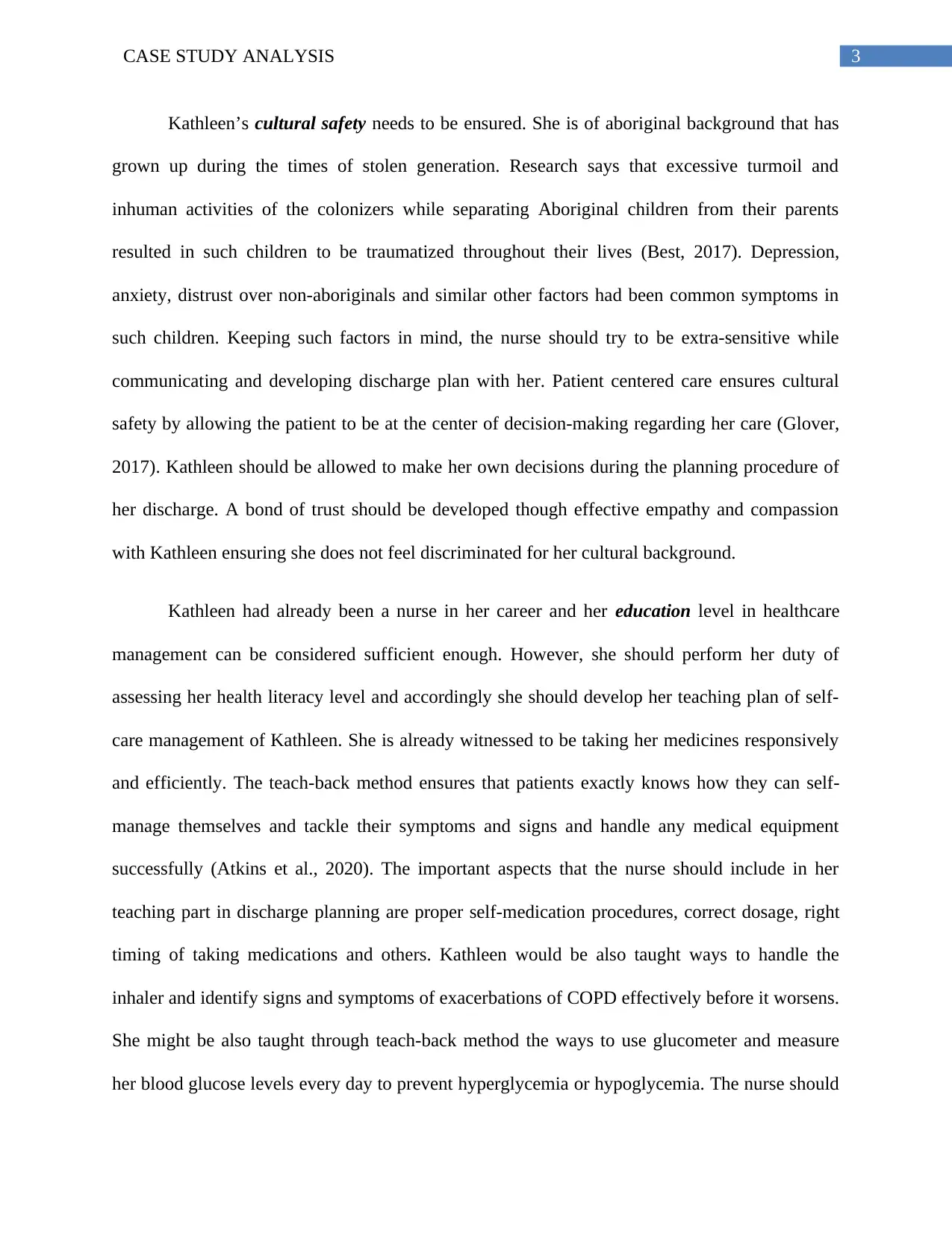
3CASE STUDY ANALYSIS
Kathleen’s cultural safety needs to be ensured. She is of aboriginal background that has
grown up during the times of stolen generation. Research says that excessive turmoil and
inhuman activities of the colonizers while separating Aboriginal children from their parents
resulted in such children to be traumatized throughout their lives (Best, 2017). Depression,
anxiety, distrust over non-aboriginals and similar other factors had been common symptoms in
such children. Keeping such factors in mind, the nurse should try to be extra-sensitive while
communicating and developing discharge plan with her. Patient centered care ensures cultural
safety by allowing the patient to be at the center of decision-making regarding her care (Glover,
2017). Kathleen should be allowed to make her own decisions during the planning procedure of
her discharge. A bond of trust should be developed though effective empathy and compassion
with Kathleen ensuring she does not feel discriminated for her cultural background.
Kathleen had already been a nurse in her career and her education level in healthcare
management can be considered sufficient enough. However, she should perform her duty of
assessing her health literacy level and accordingly she should develop her teaching plan of self-
care management of Kathleen. She is already witnessed to be taking her medicines responsively
and efficiently. The teach-back method ensures that patients exactly knows how they can self-
manage themselves and tackle their symptoms and signs and handle any medical equipment
successfully (Atkins et al., 2020). The important aspects that the nurse should include in her
teaching part in discharge planning are proper self-medication procedures, correct dosage, right
timing of taking medications and others. Kathleen would be also taught ways to handle the
inhaler and identify signs and symptoms of exacerbations of COPD effectively before it worsens.
She might be also taught through teach-back method the ways to use glucometer and measure
her blood glucose levels every day to prevent hyperglycemia or hypoglycemia. The nurse should
Kathleen’s cultural safety needs to be ensured. She is of aboriginal background that has
grown up during the times of stolen generation. Research says that excessive turmoil and
inhuman activities of the colonizers while separating Aboriginal children from their parents
resulted in such children to be traumatized throughout their lives (Best, 2017). Depression,
anxiety, distrust over non-aboriginals and similar other factors had been common symptoms in
such children. Keeping such factors in mind, the nurse should try to be extra-sensitive while
communicating and developing discharge plan with her. Patient centered care ensures cultural
safety by allowing the patient to be at the center of decision-making regarding her care (Glover,
2017). Kathleen should be allowed to make her own decisions during the planning procedure of
her discharge. A bond of trust should be developed though effective empathy and compassion
with Kathleen ensuring she does not feel discriminated for her cultural background.
Kathleen had already been a nurse in her career and her education level in healthcare
management can be considered sufficient enough. However, she should perform her duty of
assessing her health literacy level and accordingly she should develop her teaching plan of self-
care management of Kathleen. She is already witnessed to be taking her medicines responsively
and efficiently. The teach-back method ensures that patients exactly knows how they can self-
manage themselves and tackle their symptoms and signs and handle any medical equipment
successfully (Atkins et al., 2020). The important aspects that the nurse should include in her
teaching part in discharge planning are proper self-medication procedures, correct dosage, right
timing of taking medications and others. Kathleen would be also taught ways to handle the
inhaler and identify signs and symptoms of exacerbations of COPD effectively before it worsens.
She might be also taught through teach-back method the ways to use glucometer and measure
her blood glucose levels every day to prevent hyperglycemia or hypoglycemia. The nurse should
Secure Best Marks with AI Grader
Need help grading? Try our AI Grader for instant feedback on your assignments.
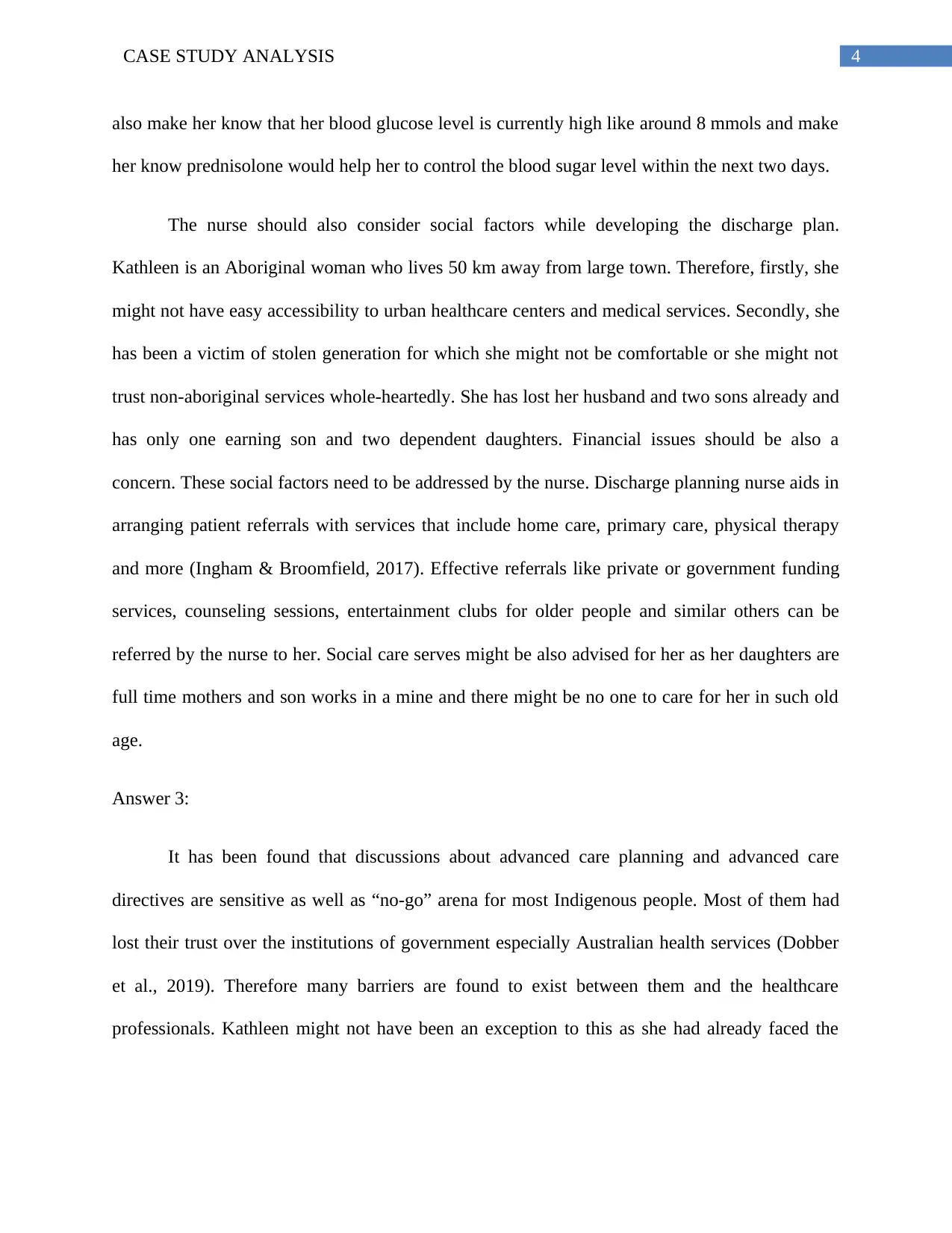
4CASE STUDY ANALYSIS
also make her know that her blood glucose level is currently high like around 8 mmols and make
her know prednisolone would help her to control the blood sugar level within the next two days.
The nurse should also consider social factors while developing the discharge plan.
Kathleen is an Aboriginal woman who lives 50 km away from large town. Therefore, firstly, she
might not have easy accessibility to urban healthcare centers and medical services. Secondly, she
has been a victim of stolen generation for which she might not be comfortable or she might not
trust non-aboriginal services whole-heartedly. She has lost her husband and two sons already and
has only one earning son and two dependent daughters. Financial issues should be also a
concern. These social factors need to be addressed by the nurse. Discharge planning nurse aids in
arranging patient referrals with services that include home care, primary care, physical therapy
and more (Ingham & Broomfield, 2017). Effective referrals like private or government funding
services, counseling sessions, entertainment clubs for older people and similar others can be
referred by the nurse to her. Social care serves might be also advised for her as her daughters are
full time mothers and son works in a mine and there might be no one to care for her in such old
age.
Answer 3:
It has been found that discussions about advanced care planning and advanced care
directives are sensitive as well as “no-go” arena for most Indigenous people. Most of them had
lost their trust over the institutions of government especially Australian health services (Dobber
et al., 2019). Therefore many barriers are found to exist between them and the healthcare
professionals. Kathleen might not have been an exception to this as she had already faced the
also make her know that her blood glucose level is currently high like around 8 mmols and make
her know prednisolone would help her to control the blood sugar level within the next two days.
The nurse should also consider social factors while developing the discharge plan.
Kathleen is an Aboriginal woman who lives 50 km away from large town. Therefore, firstly, she
might not have easy accessibility to urban healthcare centers and medical services. Secondly, she
has been a victim of stolen generation for which she might not be comfortable or she might not
trust non-aboriginal services whole-heartedly. She has lost her husband and two sons already and
has only one earning son and two dependent daughters. Financial issues should be also a
concern. These social factors need to be addressed by the nurse. Discharge planning nurse aids in
arranging patient referrals with services that include home care, primary care, physical therapy
and more (Ingham & Broomfield, 2017). Effective referrals like private or government funding
services, counseling sessions, entertainment clubs for older people and similar others can be
referred by the nurse to her. Social care serves might be also advised for her as her daughters are
full time mothers and son works in a mine and there might be no one to care for her in such old
age.
Answer 3:
It has been found that discussions about advanced care planning and advanced care
directives are sensitive as well as “no-go” arena for most Indigenous people. Most of them had
lost their trust over the institutions of government especially Australian health services (Dobber
et al., 2019). Therefore many barriers are found to exist between them and the healthcare
professionals. Kathleen might not have been an exception to this as she had already faced the
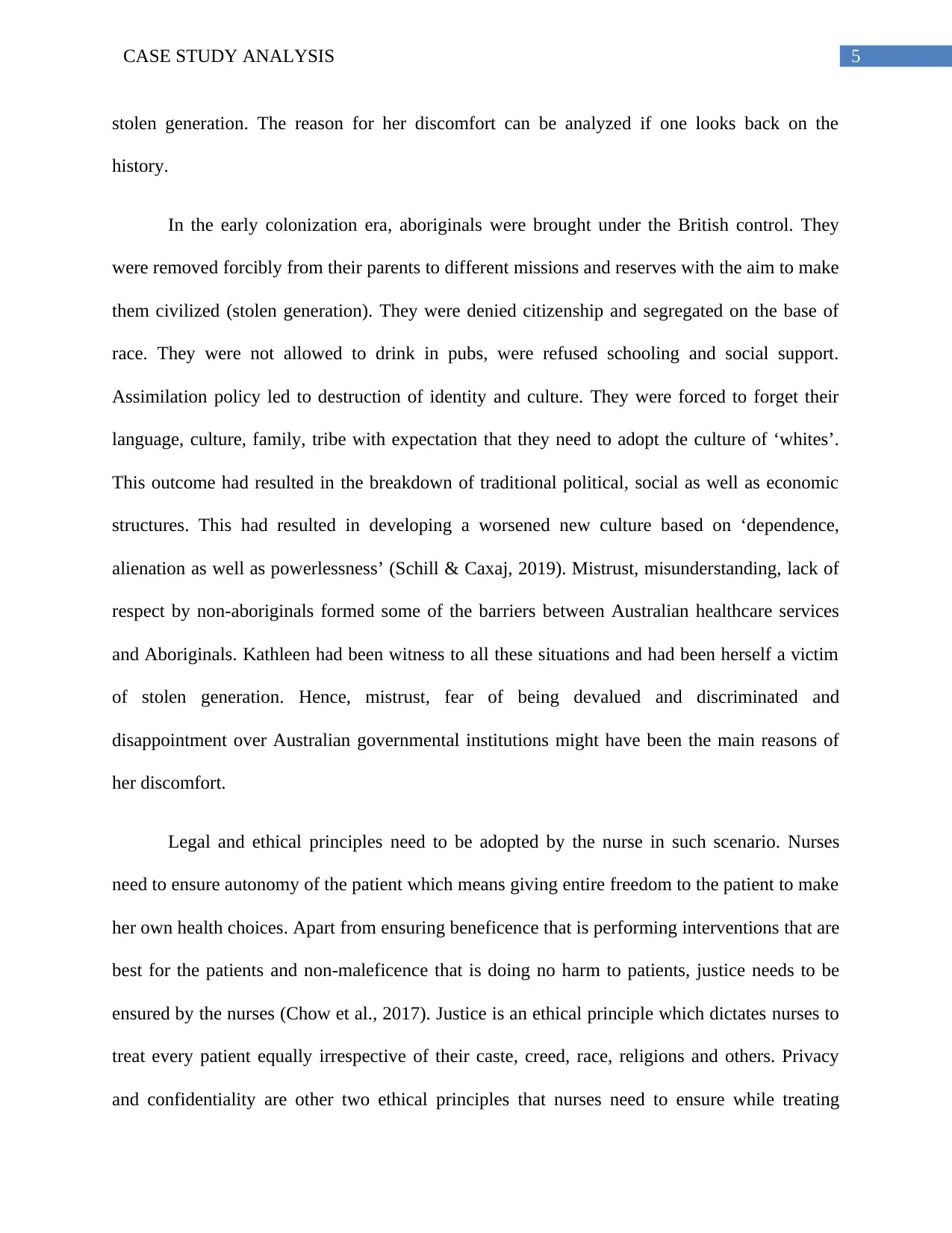
5CASE STUDY ANALYSIS
stolen generation. The reason for her discomfort can be analyzed if one looks back on the
history.
In the early colonization era, aboriginals were brought under the British control. They
were removed forcibly from their parents to different missions and reserves with the aim to make
them civilized (stolen generation). They were denied citizenship and segregated on the base of
race. They were not allowed to drink in pubs, were refused schooling and social support.
Assimilation policy led to destruction of identity and culture. They were forced to forget their
language, culture, family, tribe with expectation that they need to adopt the culture of ‘whites’.
This outcome had resulted in the breakdown of traditional political, social as well as economic
structures. This had resulted in developing a worsened new culture based on ‘dependence,
alienation as well as powerlessness’ (Schill & Caxaj, 2019). Mistrust, misunderstanding, lack of
respect by non-aboriginals formed some of the barriers between Australian healthcare services
and Aboriginals. Kathleen had been witness to all these situations and had been herself a victim
of stolen generation. Hence, mistrust, fear of being devalued and discriminated and
disappointment over Australian governmental institutions might have been the main reasons of
her discomfort.
Legal and ethical principles need to be adopted by the nurse in such scenario. Nurses
need to ensure autonomy of the patient which means giving entire freedom to the patient to make
her own health choices. Apart from ensuring beneficence that is performing interventions that are
best for the patients and non-maleficence that is doing no harm to patients, justice needs to be
ensured by the nurses (Chow et al., 2017). Justice is an ethical principle which dictates nurses to
treat every patient equally irrespective of their caste, creed, race, religions and others. Privacy
and confidentiality are other two ethical principles that nurses need to ensure while treating
stolen generation. The reason for her discomfort can be analyzed if one looks back on the
history.
In the early colonization era, aboriginals were brought under the British control. They
were removed forcibly from their parents to different missions and reserves with the aim to make
them civilized (stolen generation). They were denied citizenship and segregated on the base of
race. They were not allowed to drink in pubs, were refused schooling and social support.
Assimilation policy led to destruction of identity and culture. They were forced to forget their
language, culture, family, tribe with expectation that they need to adopt the culture of ‘whites’.
This outcome had resulted in the breakdown of traditional political, social as well as economic
structures. This had resulted in developing a worsened new culture based on ‘dependence,
alienation as well as powerlessness’ (Schill & Caxaj, 2019). Mistrust, misunderstanding, lack of
respect by non-aboriginals formed some of the barriers between Australian healthcare services
and Aboriginals. Kathleen had been witness to all these situations and had been herself a victim
of stolen generation. Hence, mistrust, fear of being devalued and discriminated and
disappointment over Australian governmental institutions might have been the main reasons of
her discomfort.
Legal and ethical principles need to be adopted by the nurse in such scenario. Nurses
need to ensure autonomy of the patient which means giving entire freedom to the patient to make
her own health choices. Apart from ensuring beneficence that is performing interventions that are
best for the patients and non-maleficence that is doing no harm to patients, justice needs to be
ensured by the nurses (Chow et al., 2017). Justice is an ethical principle which dictates nurses to
treat every patient equally irrespective of their caste, creed, race, religions and others. Privacy
and confidentiality are other two ethical principles that nurses need to ensure while treating
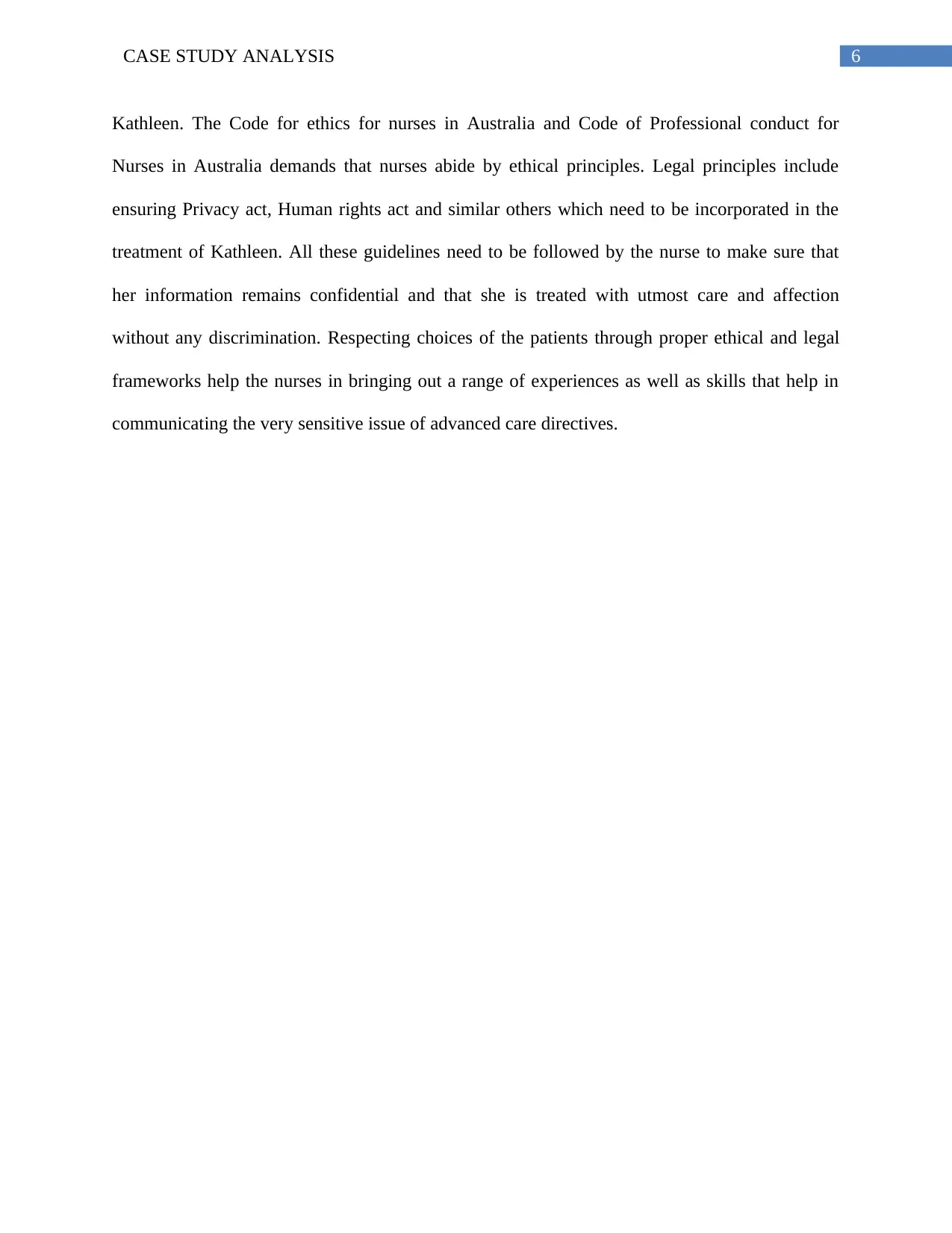
6CASE STUDY ANALYSIS
Kathleen. The Code for ethics for nurses in Australia and Code of Professional conduct for
Nurses in Australia demands that nurses abide by ethical principles. Legal principles include
ensuring Privacy act, Human rights act and similar others which need to be incorporated in the
treatment of Kathleen. All these guidelines need to be followed by the nurse to make sure that
her information remains confidential and that she is treated with utmost care and affection
without any discrimination. Respecting choices of the patients through proper ethical and legal
frameworks help the nurses in bringing out a range of experiences as well as skills that help in
communicating the very sensitive issue of advanced care directives.
Kathleen. The Code for ethics for nurses in Australia and Code of Professional conduct for
Nurses in Australia demands that nurses abide by ethical principles. Legal principles include
ensuring Privacy act, Human rights act and similar others which need to be incorporated in the
treatment of Kathleen. All these guidelines need to be followed by the nurse to make sure that
her information remains confidential and that she is treated with utmost care and affection
without any discrimination. Respecting choices of the patients through proper ethical and legal
frameworks help the nurses in bringing out a range of experiences as well as skills that help in
communicating the very sensitive issue of advanced care directives.
Paraphrase This Document
Need a fresh take? Get an instant paraphrase of this document with our AI Paraphraser
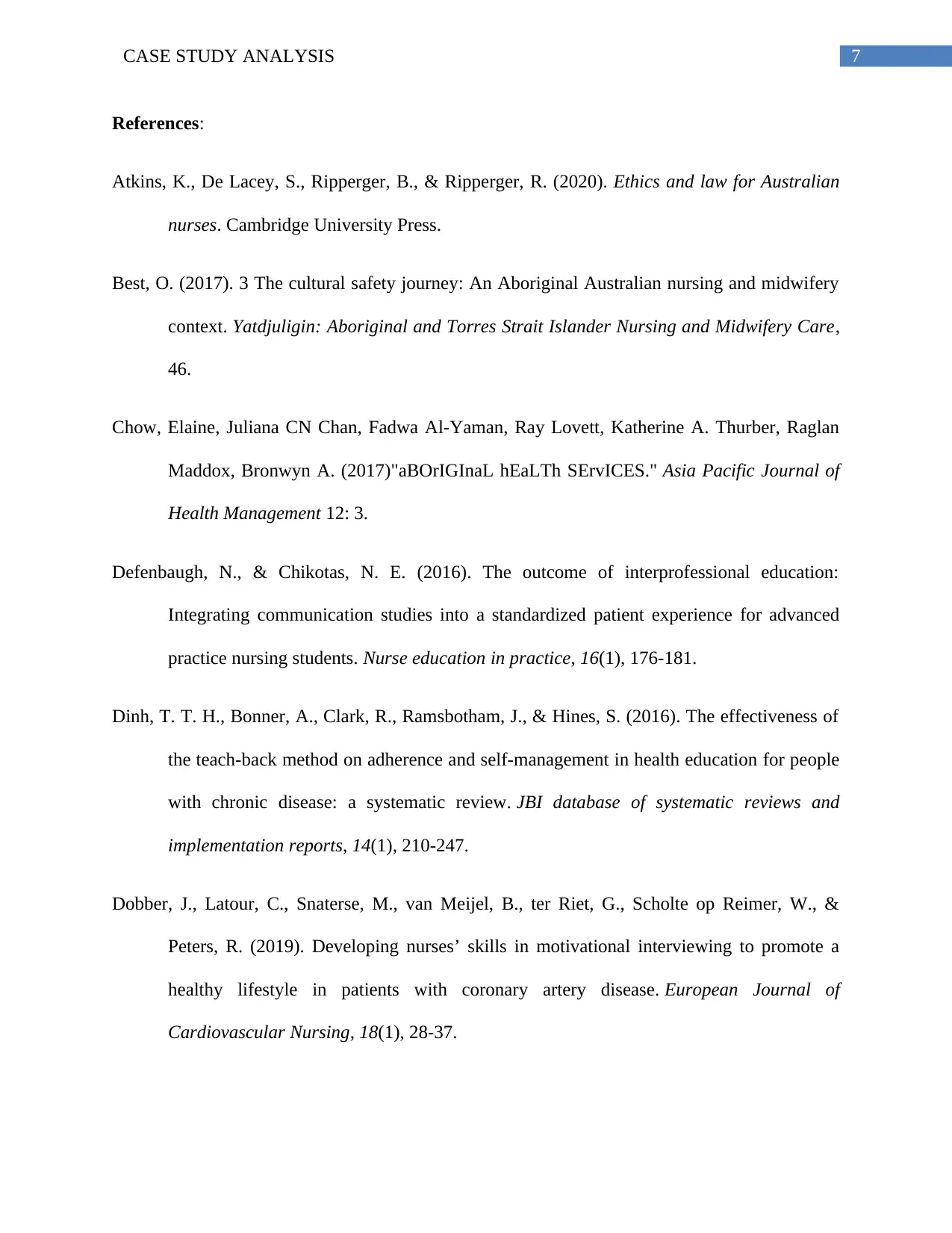
7CASE STUDY ANALYSIS
References:
Atkins, K., De Lacey, S., Ripperger, B., & Ripperger, R. (2020). Ethics and law for Australian
nurses. Cambridge University Press.
Best, O. (2017). 3 The cultural safety journey: An Aboriginal Australian nursing and midwifery
context. Yatdjuligin: Aboriginal and Torres Strait Islander Nursing and Midwifery Care,
46.
Chow, Elaine, Juliana CN Chan, Fadwa Al-Yaman, Ray Lovett, Katherine A. Thurber, Raglan
Maddox, Bronwyn A. (2017)"aBOrIGInaL hEaLTh SErvICES." Asia Pacific Journal of
Health Management 12: 3.
Defenbaugh, N., & Chikotas, N. E. (2016). The outcome of interprofessional education:
Integrating communication studies into a standardized patient experience for advanced
practice nursing students. Nurse education in practice, 16(1), 176-181.
Dinh, T. T. H., Bonner, A., Clark, R., Ramsbotham, J., & Hines, S. (2016). The effectiveness of
the teach-back method on adherence and self-management in health education for people
with chronic disease: a systematic review. JBI database of systematic reviews and
implementation reports, 14(1), 210-247.
Dobber, J., Latour, C., Snaterse, M., van Meijel, B., ter Riet, G., Scholte op Reimer, W., &
Peters, R. (2019). Developing nurses’ skills in motivational interviewing to promote a
healthy lifestyle in patients with coronary artery disease. European Journal of
Cardiovascular Nursing, 18(1), 28-37.
References:
Atkins, K., De Lacey, S., Ripperger, B., & Ripperger, R. (2020). Ethics and law for Australian
nurses. Cambridge University Press.
Best, O. (2017). 3 The cultural safety journey: An Aboriginal Australian nursing and midwifery
context. Yatdjuligin: Aboriginal and Torres Strait Islander Nursing and Midwifery Care,
46.
Chow, Elaine, Juliana CN Chan, Fadwa Al-Yaman, Ray Lovett, Katherine A. Thurber, Raglan
Maddox, Bronwyn A. (2017)"aBOrIGInaL hEaLTh SErvICES." Asia Pacific Journal of
Health Management 12: 3.
Defenbaugh, N., & Chikotas, N. E. (2016). The outcome of interprofessional education:
Integrating communication studies into a standardized patient experience for advanced
practice nursing students. Nurse education in practice, 16(1), 176-181.
Dinh, T. T. H., Bonner, A., Clark, R., Ramsbotham, J., & Hines, S. (2016). The effectiveness of
the teach-back method on adherence and self-management in health education for people
with chronic disease: a systematic review. JBI database of systematic reviews and
implementation reports, 14(1), 210-247.
Dobber, J., Latour, C., Snaterse, M., van Meijel, B., ter Riet, G., Scholte op Reimer, W., &
Peters, R. (2019). Developing nurses’ skills in motivational interviewing to promote a
healthy lifestyle in patients with coronary artery disease. European Journal of
Cardiovascular Nursing, 18(1), 28-37.
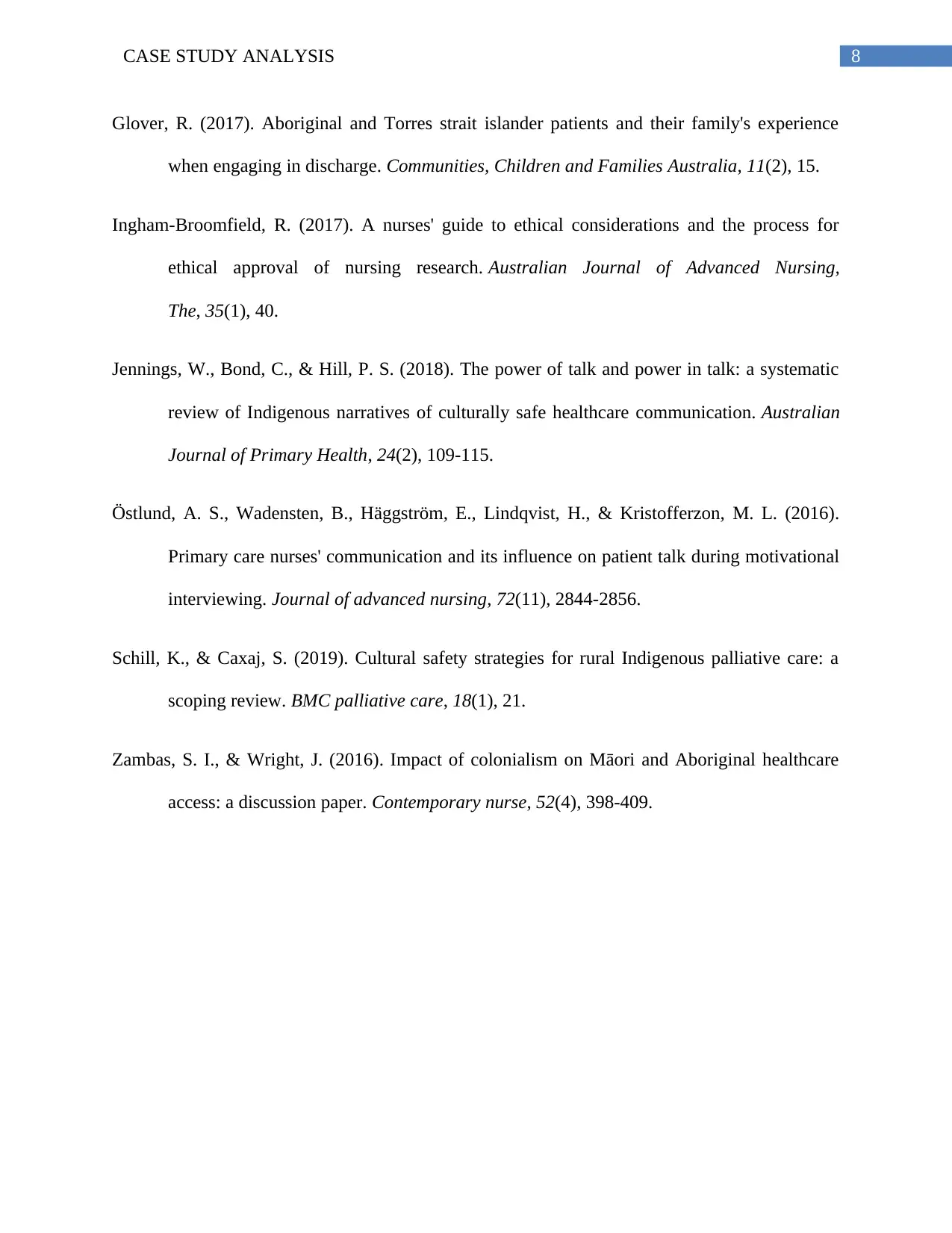
8CASE STUDY ANALYSIS
Glover, R. (2017). Aboriginal and Torres strait islander patients and their family's experience
when engaging in discharge. Communities, Children and Families Australia, 11(2), 15.
Ingham-Broomfield, R. (2017). A nurses' guide to ethical considerations and the process for
ethical approval of nursing research. Australian Journal of Advanced Nursing,
The, 35(1), 40.
Jennings, W., Bond, C., & Hill, P. S. (2018). The power of talk and power in talk: a systematic
review of Indigenous narratives of culturally safe healthcare communication. Australian
Journal of Primary Health, 24(2), 109-115.
Östlund, A. S., Wadensten, B., Häggström, E., Lindqvist, H., & Kristofferzon, M. L. (2016).
Primary care nurses' communication and its influence on patient talk during motivational
interviewing. Journal of advanced nursing, 72(11), 2844-2856.
Schill, K., & Caxaj, S. (2019). Cultural safety strategies for rural Indigenous palliative care: a
scoping review. BMC palliative care, 18(1), 21.
Zambas, S. I., & Wright, J. (2016). Impact of colonialism on Māori and Aboriginal healthcare
access: a discussion paper. Contemporary nurse, 52(4), 398-409.
Glover, R. (2017). Aboriginal and Torres strait islander patients and their family's experience
when engaging in discharge. Communities, Children and Families Australia, 11(2), 15.
Ingham-Broomfield, R. (2017). A nurses' guide to ethical considerations and the process for
ethical approval of nursing research. Australian Journal of Advanced Nursing,
The, 35(1), 40.
Jennings, W., Bond, C., & Hill, P. S. (2018). The power of talk and power in talk: a systematic
review of Indigenous narratives of culturally safe healthcare communication. Australian
Journal of Primary Health, 24(2), 109-115.
Östlund, A. S., Wadensten, B., Häggström, E., Lindqvist, H., & Kristofferzon, M. L. (2016).
Primary care nurses' communication and its influence on patient talk during motivational
interviewing. Journal of advanced nursing, 72(11), 2844-2856.
Schill, K., & Caxaj, S. (2019). Cultural safety strategies for rural Indigenous palliative care: a
scoping review. BMC palliative care, 18(1), 21.
Zambas, S. I., & Wright, J. (2016). Impact of colonialism on Māori and Aboriginal healthcare
access: a discussion paper. Contemporary nurse, 52(4), 398-409.
1 out of 9
Related Documents
Your All-in-One AI-Powered Toolkit for Academic Success.
+13062052269
info@desklib.com
Available 24*7 on WhatsApp / Email
![[object Object]](/_next/static/media/star-bottom.7253800d.svg)
Unlock your academic potential
© 2024 | Zucol Services PVT LTD | All rights reserved.




